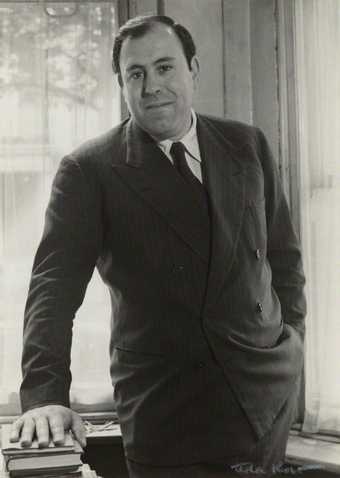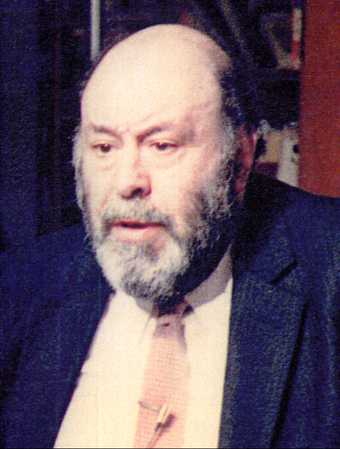
David Sylvester c.1960
National Portrait Gallery, London
Photo: Ida Kar
During the spring of 1960 a few weeks after Senator John F. Kennedy announced his intention to run for President, the critic David Sylvester spent two months in the United States. It was his first visit to the country.1 Like many in London he had undergone a ‘Damascene conversion’ to abstract expressionism after seeing the Museum of Modern Art’s touring exhibition Modern Art in the United States, shown at the Tate Gallery early in 1956.2 But he had had relatively little direct contact with the American art scene beyond this and a handful of other exhibitions of American art in London, and his work as a London correspondent for such publications as the New York Times, Arts and Art News.3 The artist Richard Hamilton later observed about British understanding of American art in these years, ‘we were completely isolated here from the work going on in New York, other than abstract expressionism or, I suppose in the mid-1950s, hard-edged abstraction.’4
Fellow critic Lawrence Alloway, whom Sylvester considered ‘so ardent a champion of things American that he could fairly be described as a walking outpost of American civilization’, had visited the US in 1958 as the recipient of a State Department grant (and would later move there permanently in 1961).5 Alloway had intended to visit leading American artists and critics for the BBC while in the US, and he corresponded with his producer at the BBC, Leonie Cohn, outlining his ideas. Cohn in turn wrote to a ‘Miss L. Lang’ at the BBC in New York, to make arrangements: ‘Names that have been mentioned are Mark Rothko, Willem de Kooning, Franz Kline, perhaps Robert Motherwell. I should also like to have one or two critics in the programme – perhaps Harold Rosenberg and Clement Greenberg.’6
After further discussions, Alloway refined his selection to Rothko, Kline, de Kooning and Rosenberg, but the interviews never took place and Alloway wrote to Cohn ‘basically I blame Rosenberg’.7 Alloway had hoped for Rosenberg’s assistance in corralling the artists into the studio, particularly de Kooning, who he never managed to meet during this visit. He did, however, write that although Rothko refused to be interviewed, ‘he gave me a superbly eloquent account of why silence is so good for artists. I wish we could have taped that!’8
It was as part of the same State Department programme that Sylvester went to the US in 1960. Fellow grant recipients in the same year included the Sunday Times art critic John Russell (who also moved to the US later in his career) and Gabriel White of the Arts Council.9 Interestingly, it was Sylvester’s work for the American magazine Encounter which was highlighted in the records listing his involvement in the programme rather than any of his other work as a critic.10 In the 1960s Encounter found itself at the centre of a scandal when it emerged that the magazine, which was ostensibly funded by the anti-communist Congress for Cultural Freedom, was in fact financed by the CIA. Neither Sylvester nor the magazine’s British co-editor Stephen Spender, however, admitted to any knowledge of this arrangement.
Sylvester’s interview project was more successful than Alloway’s. He recorded a series of six interviews in March and April 1960 which were broadcast on the BBC Third Programme later that year.11 Sylvester’s experience with de Kooning, for example, was in stark contrast to Alloway’s. The latter had been unable to meet de Kooning at all, but Sylvester (who had avoided trying to secure an introduction to him through official channels) was delighted when the artist came to a dinner party thrown in Sylvester’s honour by the former Encounter co-editor Irving Kristol. Asked whom he would like to invite, Sylvester had said Harold Rosenberg, and when Rosenberg’s wife was unable to accompany him to the dinner, de Kooning joined him instead.12 In Sylvester’s view, de Kooning’s interest in meeting him was the result of his recent writing in American publications: ‘A few months earlier I’d published in the New York Times an article on Soutine in which I suggested that he’d lately been having a significant influence, nowhere more so than in certain recent paintings by de Kooning, and that his art in itself was less interesting than the possibilities it contained, especially those which had been realised by de Kooning. Now at that time it was not public knowledge that de Kooning adored the work of Soutine. He may therefore have been curious to meet a writer who’d seen for himself a connection between them.’13
The dinner was a momentous occasion for Sylvester, as he recalled in ‘Curriculum Vitae’, the introduction to his 1996 book of critical essays About Modern Art: ‘After dinner […] de Kooning proposed we repair to the Cedar Bar. There he introduced me to Franz Kline, David Smith and Philip Guston among others. The night concluded at 7 am after a Chinese meal and a drive round Manhattan Island with Guston […] It had, of course, been like the evening chez Kahnweiler in transforming my life.’14 The evening ‘chez Kahnweiler’ had happened in 1948 when Sylvester, then in his early twenties and living in Paris, was invited to coffee by the legendary dealer Daniel-Henry Kahnweiler, where his fellow guests included artists Alberto Giacometti and André Masson and other Parisian luminaries.15 By drawing a parallel between the two encounters, Sylvester made it clear that he had adopted a new set of heroes, who ‘came out of a whiskey culture’ rather than the ‘wine culture’ of Kahnweiler’s coterie.16 The visit to the States instilled in Sylvester a fascination with New York that would never leave him. As he wrote in ‘Curriculum Vitae’, ‘living in London, my heart and head have been in New York. The city itself is the most variedly beautiful place I know and feels more and more so’.17 He loved its grid structure and its energy, and immersed himself in the social life of the city.
Another memorable occasion during Sylvester’s time in New York was the reading of his monograph on Giacometti (which because of Sylvester’s characteristic perfectionism would not be published until 1994) to an audience of artists at ‘the Club’ on 8th Street. As Irving Sandler later recalled, ‘he began at 10 pm and finished at 2 am’.18 Sylvester was unimpressed, however, by an event that was deemed by many to be ground-breaking – the self-destruction of the machine-piece by Swiss artist Jean Tinguely Homage to New York in the grounds of the Museum of Modern Art on 18 March 1960. According to the eye-witness account of the writer Calvin Tomkins, Sylvester left the event early, accompanied by ‘two noted Abstract Expressionist painters’, and muttering about his dislike of ‘tuxedo dada’.19
While Sylvester spent most of his time in New York, he also visited San Francisco and Los Angeles.20 San Francisco held little interest for him, and he described it as ‘too relaxed, too easy, beauty on the cheap, with a lack of grandeur in the forms of the landscape to match its scale’. He admitted, however, ‘I’d rather fallen for Los Angeles by the time I left’ to the critic Jules Langsner, who showed him around the city.21 In Los Angeles Sylvester also spent an evening with Christopher Isherwood and recorded a conversation for the BBC with the writer Gavin Lambert and director Stanley Kubrick. Kubrick and Sylvester got on well, and while Sylvester was in Los Angeles Kubrick also invited him to dinner and showed him around Universal Studios.22 They went on to become good friends, culminating in Sylvester working in an uncredited role as ‘special writer’ on Kubrick’s 1961 film adaptation of Lolita.23
Looking back on his trip to the US in 1996, Sylvester recognised ‘the art I was involved in was in the past’.24 He had seen an exhibition of Robert Rauschenberg ‘without beginning to realise how good it was’, and it was not until his next visit to the US, in 1965, that he interviewed Jasper Johns and Barnett Newman, who he would come to view as the most important painters of the 1960s. His first visit to the States was above all a way of catching up with a generation of artists whose dominance of the contemporary art scene was coming to an end. Pop art, hard-edge painting and minimalism succeeded abstract expressionism as the dominant trends in American art in the course of the 1960s. Franz Kline died in 1962 and the death of David Smith followed in 1965; Philip Guston moved away from abstraction between 1966 and 1968.
Sylvester’s trip, however, marked the beginning of what was to prove a distinctive aspect of his practice as a critic, namely, his use of the artist interview. Over the next forty years he regularly interviewed both British and American artists, developing an approach that focused above all on the artists’ working processes.25 In 1985 Sylvester summarised the benefits of his conversations with artists when he told critic Richard Cork: ‘I’ll tell you what I think getting to know any artist does. It tends to rid you of false ideas which you have about the way he might be thinking.’26 This approach to interviews accounts perhaps for why so many artists found Sylvester a sensitive champion of their work. After Sylvester reviewed Guston’s 1963 exhibition at the Whitechapel Gallery, the artist wrote to him: ‘rereading it many times now I feel it is the most serious review my work has ever received. It felt close to my own feelings instead of being an interpretation of the work.’27



